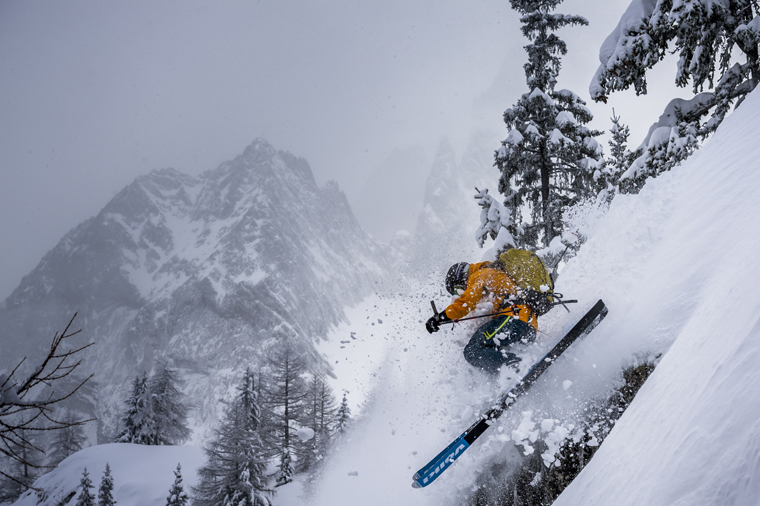15 minutes with ski legend Stian Hagen


Stian Hagen: Yes, it was a sales meeting to show next year’s skis to all the distributors.
Rad dad: “We were real ski bums. I feel sorry young skiers now don’t get that experience…”| Adam Clark
SH: Well, it was mainly freeride stuff, showing some narrower skis for off-piste.
SH. Ha! Close on 15 years, I think.
SH: I’ve always been interested in equipment and technology. Before I started skiing professionally I worked in Norway in a climbing shop. I’m always tweaking my gear to make it better and I come at a problem from a more radical perspective.
SH: I’m working more on boots and bindings these days, but some of the earlier rockered skis had a lot of input from me.
Ski changes are more incremental, but boots and bindings have become game-changing lately.
Stian demoing some of Völkl’s finest | Photos Dan Milner/Völkl
SH: It’s 12 years since we came up with the Marker Duke binding and I learned a lot on that project and the whole ‘royal family’ range. It was game-changing, but of course the design has aged. We wanted to get into the pin-tech binding market but not to copy the competition. We looked at not just skiability but safety. The pin-tech binding has a release function, but it’s not what you want as a freerider. There were also power transfer problems, and while weight is an issue, freeriders go up to have a great ride down – they don’t bail on a 200m climb to a peak because their binding is 100g too heavy.
SH. I’ve never thought about it that way. It was 25 years ago and they’re different disciplines, but I guess maybe learning how to jump big, as a kid, shows you have a capability to handle fear.
SH: I came when I was 18 in 1994 and have stayed pretty much ever since. It has a lot to offer – but mainly easy access to high mountains. It’s also a proper year-round town, and it’s easy to travel from, being only an hour from Geneva airport. When you travel a lot that makes a difference.
SH: So far so good. Maybe there will be issues as they get older about it being such a crazy ski town. As both Andrea (Stian’s wife Andrea Binning, an Australian pro skier) and I know the pressures that come with the lifestyle, we would never want our kids to feel they were being pushed into being pro skiers.
SH: We were real ski bums then and I feel kind of sorry that young skiers now don’t get that experience! With social media and so on it’s about so much more than skiing. We just went out and skied and didn’t have to document it on Facebook. No one had a phone so you just met people at the bottom of the lift.
SH: I have a real passion for skiing, but I’ve also been able to adapt my career to changes in the industry. Being able to do more for your sponsor than just being a skier is critical.
You can only have so many superstars on your team; there are other things you need, such as being able to talk to dealers and distributors about equipment in a way they can engage with.
SH: In an office I wouldn’t have value. What I bring to the brands is that I’m out seeing what’s going on in the industry and testing gear. They realise – it’s taken some years to convince them – that they need people they can trust who are part of the scene; it helps the brands to remain at the cutting edge..
Not a bad day at the office… | Dan Milner/Völkl
SH: I was sitting in the sauna with Ian last week talking about this. For me what changed was getting the mountain guide qualification and understanding more about risks; and of course having a family. We’ve lost a lot of friends over the past ten years and all that stuff starts adding up when you’re making decisions. And with age you realise that if you’ve taken risks for a long time, sooner or later you’re going to run out of luck. The mountains are a dangerous environment, so I don’t feel the same urge to be the first guy up on the lift any more.
SH. No, it’s the riders who put pressure on themselves if they want to become pro skiers. It’s easier for me than for a young rider to say no: I have nothing to prove. Social media plays a negative role, not just because someone may be driven to ski a line to show they were first; but because social media can alert people to a line being in condition, so it gets skied out. The environment is more stressful. It’s a shame, as social media could be used to improve safety, by sharing information on snow conditions and improving knowledge. I hope riders get safer by better understanding risk, but I do fear for the future.
SH: I’m working on a project in Norway on hut-to-hut touring in regions that aren’t so well known to people outside Norway. I’m in London soon to discuss it with Visit Norway, the tourist organisation, so watch this space; I think it will be really special.
Stian is sponsored by Völkl, Arc’teryx, Marker and more.
Read the full interview with Stian in our backcountry issue, out now.